English Nursery Rhymes with Unexpected and Sometimes Disturbing Historical Origins
Many people associate nursery rhymes with reading happy stories to children, or remember being children themselves and chanting them while they play. However, the popular explanations for the origins of several English nursery rhymes shows that they may be more complex and at times more disturbing than they first appear.
There is controversy regarding exact dates when they were created and the message behind some of these rhymes. Nonetheless, most researchers agree that often the rhymes were meant to provide morals and values, or warnings, to their audience.
Some researchers have also suggested that these seemingly nonsensical rhymes were not really meant for children at all, nor are they nonsense. Instead, the rhymes were steeped with political and satirical messages, created in such a way to confuse the authorities listening; thus, preventing legal or other backlash.
1. Baa Baa Black Sheep: Feudal Taxes
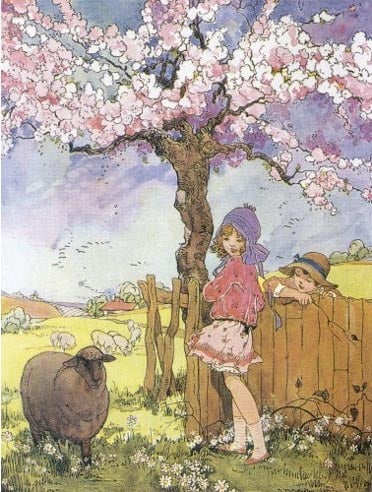
Baa Baa Black Sheep (1916) Dorothy Miller (Wikimedia Commons)
Baa baa black sheep, have you any wool?
Yes sir, yes sir, three bags full!
One for the master, one for the dame
But none for the little boy who cries down the lane. (Final line until the late 16th century)
-OR-
And one for the little boy who lives down the lane. (Changes to be more suitable for children.)
Baa Baa Black Sheep was first published in 1744. However, most scholars claim that this rhyme is based on the reality of life in feudal times in England in general and the export tax for wool farmers of 1275 created by King Edward I (the master) in particular. The "bags of wool" (or produce from the farmers) first went to the nobles, then the church, and in the end practically nothing was left for the poor "little boy" (farmers).
2. Mary Mary Quite Contrary: A Cruel or Tragic Queen
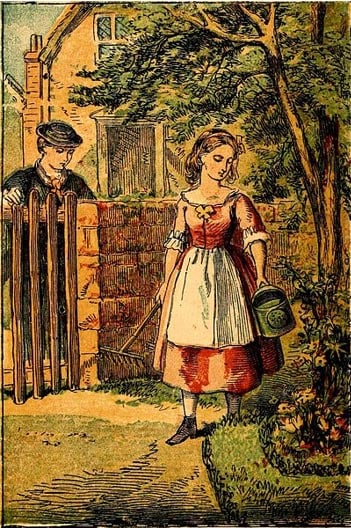
Mary, Mary Quite Contrary (1860) (Wikimedia Commons)
Mary Mary quite contrary,
How does your garden grow?
With silver bells and cockle shells
And pretty maids all in a row
According to some researchers Mary Mary, also published in 1744, refers to "Bloody Mary" Mary Tudor or Mary Stewart - Mary Queen of Scots. Mary Tudor was a strict Catholic and during her reign from 1553-1558 her garden (a graveyard) grew as many protestants were executed for not converting to Catholicism. "Silver bells" and "cockle shells" may have been the nicknames of torture devices (thumbscrews and instruments attached to the genitals). The "maids" (shortened from maiden) in the rhyme is thought to be another nickname - for another device for torture or the guillotine.
If Mary Queen of Scots is the Mary referred to, then the "silver bells" and "cockle shells" are said to be a mention to ornaments she received on a dress from her first husband, the Dauphin Francis II of France. In this interpretation the "pretty maids" are Mary Stewart's ladies in waiting.
- The short and brutal rule of Chinese Emperor Fu Sheng, the one-eyed tyrant
- Do Spirit Pond Inscriptions show that the Holy Grail was taken to North America?
- Pandora, the Goddess who Unleashed both Hell and Hope upon Humanity
3. Goosey, Goosey, Gander: Religious Persecution/an Obligation to Pray
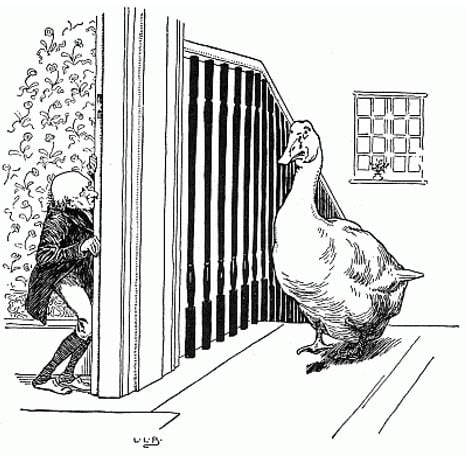
Goosey, Goosey, Gander (Mamalisa)
Goosey, goosey, gander,
Whither dost thou wander?
Upstairs and downstairs
And in my lady's chamber.
There I met an old man
Who wouldn't say his prayers;
I took him by the left leg,
And threw him down the stairs
First published in 1784, Goosey, Goosey, Gander also refers to the Catholic persecution in the 16th century. At the time "priest holes" became popular as Catholics set up small hidden rooms in their homes to pray. If zealous Protestants found the Catholic praying in Latin, than the whole family would be executed. The "left leg" in the rhyme is claimed to be the nickname for Catholics at the time as "left-leggers."
Another interpretation suggests that this rhyme may simply be a warning by its creator for listeners/readers to pray or they will receive unfortunate consequences.
4. Humpty Dumpty: A Heavy Person Or a Cannon
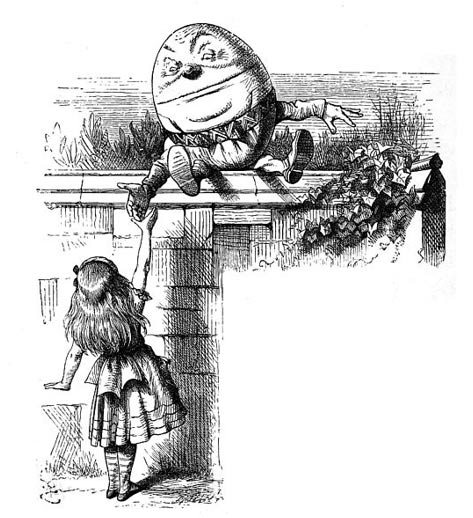
Humpty Dumpty and Alice from Through the Looking Glass, J. Tenniel (Wikimedia Commons)
Humpty Dumpty sat on a wall,
Humpty Dumpty had a great fall.
All the King's horses, And all the King's men
Couldn't put Humpty together again!
-OR-
Threescore men and threescore more,
Could not place Humpty as he was before.
Humpty Dumpty (published in 1799) also has two possible meanings. A "Humpty Dumpty" is claimed to be a nickname used in the fifteenth century for an overweight person.
The second explanation for the rhyme states that Humpty was the nickname of a cannon used by the army of King Charles I to capture Colchester in the English Civil War. The cannon reportedly "sat on a wall" of a church until it "had a great fall" as it was knocked down by opposing cannon fire. "Humpty" the cannon could not be repaired despite the efforts of "all the King's men."
It must also be noted that this rhyme and others, have counterparts in other European cultures.
5. Jack and Jill - Liquid Measures and Beheaded Royalty

Jack and Jill, Denslow (1902) (Wikimedia Commons)
Jack and Jill went up the hill,
To fetch a pail of water.
Jack fell down,
And broke his crown;
And Jill came tumbling after.
Scholars have provided two main beliefs regarding the origins of Jack and Jill, which was published in 1765. The more devious version of the rhyme refers to the beheading of France's Louis XVI (Jack) and Marie Antoinette (Jill), with the French royalty gaining status "up the hill" first and later their execution as Jack breaks his crown and Jill tumbles after. This meaning has been cast off by many however as the date of the rhyme is before their executions.
The more favored interpretation is that this rhyme, like Baa Baa Black Sheep, is a response to the reform of taxes on liquids put into place by King Charles I. It is said that "Jack" was the nickname for a half-pint (1 cup) and "Jill" was a quarter-pint (1/2 cup).
- Our Ancient Origins: The Cycles of Time & The Kali Yuga - Part 1
- Tracing the Origins of Europe, through Goddess Europa, Back to Jeroboam?
- The ancient fairy tale of Cupid and Psyche, where love endures against all odds
- The Secret Lives of Elves and Faeries: The Truth behind the Story of Rev Robert Kirk
6. Sing a Song of Sixpence - And Scare the King or Join the Pirates
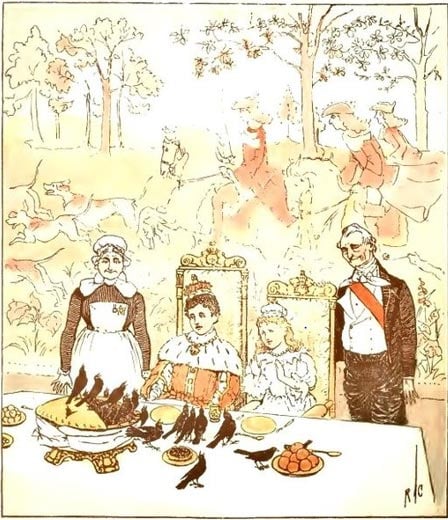
Sing a Song of Sixpence (1890) (Wikimedia Commons)
Sing a song of sixpence a pocket full of rye,
Four and twenty blackbirds baked in a pie.
When the pie was opened the birds began to sing,
Oh wasn't that a dainty dish to set before the king?
The king was in his counting house counting out his money,
The queen was in the parlor eating bread and honey
The maid was in the garden hanging out the clothes,
When down came a blackbird and pecked off her nose!
The most popular explanation for Sing a Song of Sixpence is that blackbirds (or any birds) were actually baked into pies for kings/nobles in the 16th century as a surprise and joke from the cook/a jester. This act has been documented and some cookbooks from the time included recipes on how to complete the task.
Another origin for Sing a Song of Sixpence, which was first put in print in 1744, is that it was a code used by pirates in the early 1700s to find new recruits. It was supposedly popular for those enlisting for the famous pirate Blackbeard in particular.
Blackbeard is said to have paid his crew members "sixpence" a day (an uncommon practice for pirates of his time) and the crew members "four and twenty" of Blackbeard "blackbird" were hidden in the ship "pie." The pirates' goal was to get the treasure "tasty dish" for Blackbeard "the king." The king "counting out his money" showed that Blackbeard had the money to pay the new recruits well. The "Queen," (the Queen's Revenge - Blackbeard's ship) was taking on supplies in dock "eating bread and honey" thus it was time to join on. The last two lines are explained as maritime references.
7. Ring Around the Rosie (Ring a Ring o' Roses): A False Understanding?

Ring a-round-a roses (1912) J. Willcox Smith (Wikimedia Commons)
Ring a Ring O' Roses,
A pocketful of posies,
Atishoo! Atishoo!
We all fall down!
Many people believe they know the origins of Ring a ring o' Roses: The Black Death (1348) or the Great Plague (1665) (thus the chanting of "a tishoo" and "we all fall down" [dead]). With the symptoms of the plague presenting themselves as a red ring (ring o' roses) and posies supposedly providing protection (in the common belief at the time of the Great Plague), this connection is understandable. Furthermore, another modern version of the rhyme has been altered to use the word "ashes" in place of "atishoo," supporting the hypothesis with the idea of burning the corpses of plague victims.
Nonetheless, this association is modern according to scholars who now doubt the relationship between either of the events and the rhyme. Their reasoning is that the first known documenting of the rhyme is 1881, much later than either plague. The question many researchers have asked is: why did it take so long to write it down if it was so popular?
Meanings and Origins in Recent Interpretations?
That question may be asked about many of these rhymes. Were they just passed on orally in the beginnings as a further form of protection, as the messages were hidden in the "nonsensical" rhymes? There is still debate on this topic.
To reiterate, the ideas presented here are just some of the more agreed upon interpretations of the origins and messages behind these nursery rhymes. As time passes and verses change to appeal to younger audiences, the beliefs on the origins and meanings will undoubtedly change as well. As culture is created and changes over time, so too has society created these interpretations.
Featured Image: The Jessie Willcox Smith Mother Goose (1914) (Wikimedia Commons)
References:
Alchin, Linda, 2015. Nursery Rhymes: Lyrics, Origins & History. [Online]
Available at: http://www.rhymes.org.uk
Castelow, Ellen, 2015. Nursery Rhymes. [Online]
Available at: http://www.historic-uk.com/CultureUK/Nursery-Rhymes/
Fallon, Claire, 2014. The Shocking, Twisted Stories Behind Your Favorite Nursery Rhymes. [Online]
Available at: http://www.huffingtonpost.com/2014/11/20/nursery-rhymes-real-stories_n_6180428.html
n.a., 2015. Baa Baa Black Sheep - Versions 1,2,3. [Online]
Available at: http://www.mothergooseclub.com/rhymes_parent.php?id=111
n.a. 2015. Mary Tudor. [Online]
Available at: http://www.biography.com/people/mary-tudor-9401296#spanish-marriage-and-death
n.a. Mary, Queen of Scots: Biography, Facts, Portraits & Information. [Online]
Available at: http://englishhistory.net/tudor/relative/mary-queen-of-scots/
n.a., 2015. 24 Terrifying, Thoughtful and Absurd Nursery Rhymes for Children. [Online]
Available at: http://brainz.org/24-terrifying-thoughtful-and-absurd-nursery-rhymes-children/
n.a., 2015. A Pocket Full of Wry. [Online]
Available at: http://www.snopes.com/lost/sixpence.asp
Wood, Jennifer M, 2015. The Dark Origins of 11 Classic Nursery Rhymes. [Online]
Available at: http://mentalfloss.com/article/55035/dark-origins-11-classic-nursery-rhymes
















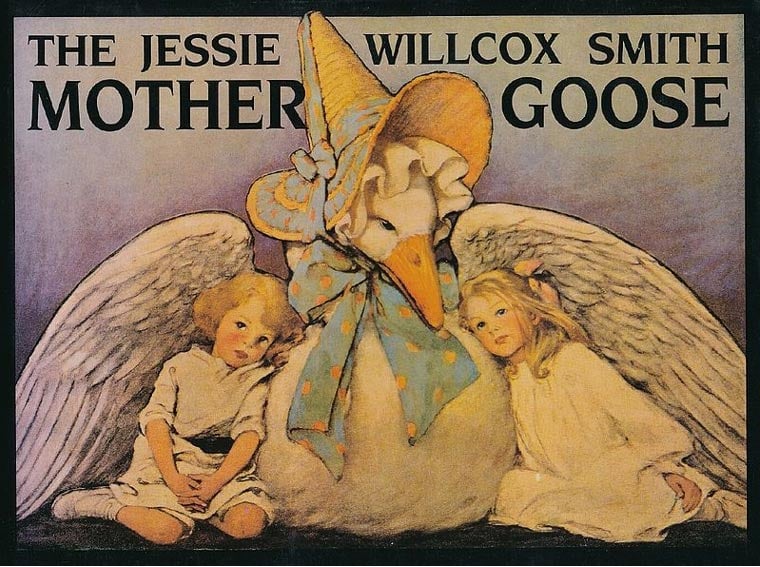

Comments
For the historical and anthropological record, in late 1950s Scots Irish northern Texas, we held hands in a circle per your J.W. Smith pic and sang:
Ring around the rosies, a pocket full of posies,
Ashes, ashes, we ALL FALL DOWN!
Whereupon we gleefully laughed and fell down (can you imagine at our age now voluntarily falling down ??).
Later at university in Texas, I heard it explained that it referred to “the” horrible bubonic plague in medieval England, where posies (which grew in Texas) were stuffed into pockets to mitigate the awful stench of death.
----------------------
Fide et Literis
Actually the guillotine was used as early as the 1200s. A simple wiki search can tell you THAT much. Perhaps researching YOUR opinions BEFORE posting might be a better idea?!?
guillotine had not been invented in1500's or by 1744. Iron Maiden was tho. Most 6 years old horror fans know that.
SO that alone makes it all questionable. DOES no one ever proof read these for such nonsense?
left leg. Yes Catholics were persecuted. by never ave read that entire families were executed over praying Latin. Praying in Hebrew or Ladino in Iberia, maybe
Jack and Jill sounds to me like it could be foreshadowing of things to come later on in France at that time.
Peace and Love,
Ricky.
Very cool. Thanks!!
Pages